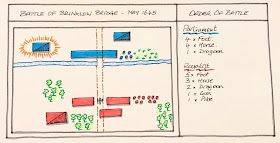 |
| Troops deployed ready for the game at Brinklow Bridge, May 1645 |
 |
| Deployment positions |
- Foot (combined musket and pike) = D3+2
- Horse D3+2
- Dragoon (or commanded shot) = D3
- Guns or special units = D3-1
Special units are Lobsters for Parliament and Elite Pike for Royalist.
Parliament were going to take up a defensive posture in this game as they had fewer units, nine versus twelve units in the Royalist force. They planned to hold fast behind the stream with their Foot, which while being fordable provided them with a good defensive position when it came to push-of-pike.
A quick note on deployment rules:
- Defenders place half their units (rounding up fractions)
- Attackers place all their units
- Remaining defending units are placed.
Battle of Brinklow Bridge - May 1645
With Parliamentarian forces taking up defensive positions behind the stream, The Royalist commander pushed up his line of Foot and Gun, very quickly both sides were soon engaged in an exchange of Musketry. Parliament's Foot units loosed off some very effective volleys and as a consequence were soon out of ammunition. While Royalist Foot units maintained a slow and steady rate of fire supported by their gun.
 |
| Royalist advance and musketry is exchanged |
This was not the desired situation for the Parliamentarian commander, who berated his officers for their lack of control. He could only watch as his Foot unit's cohesion levels were being whittled away by steady musketry. They would soon be poorly placed to withstand a push-of-pike contest, even with using the stream as a defensive advantage. To rectify the situation and to use his slight advantage in Horse, he sent orders to both wings of Horse to advance.
The Royalist commander seeing the threat of Parliamentarian Horse on his right flank ordered a unit of Horse across to counter the move and bolster the Dragoons on the right. Other than that the morning had been going better than expected for him. The loss of a Foot unit, while concerning, had not perturbed him as Parliamentarian musketry had dwindled and was becoming increasingly sporadic.
 |
| Parliament's Horse can be seen in the foreground and in the distance attacking |
At midday Parliament's Horse units crossed the stream and launched themselves into the Royalist flank units. With a slight advantage in Horse on the left they soon had nullified the Royalist Dragoons who were proving to be exceptionally accurate shots, and on the right flank the news would prove even more favourable as they routed the Royalist Horse. However, these successes were late in the battle and the damage from Royalist muskets had been done. Parliament's Foot units in the centre with no knowledge of their Horse units success and in the fog of war finally gave up and left the field.
 |
| Game moves |
A victory to the Royalists, and quite a crucial one which tightens their squeeze on Parliament and the regions around London.
 |
| The campaign map after the battle |

What an interesting outcome and narrative, with success on the flanks and collapse in the centre. The flank / centre relationship thing and the timing / point of collapse is very English Civil War.
ReplyDeleteIt was an interesting decision for the Royalists. Keep pushing in the centre and ignore the flank situation or siphon off units from the centre.
DeleteAre there consequences (losses) carried over from one battle to the next? Also I'm hoping parliament will get a bonus for London, perhaps 1 infantry extra unit (or infantry re-roll) in London or an adjacent region (I'm biased so I'd also give them an extra free artillery unit in London itself).
ReplyDeleteA useful balancing mechanism for ECW campaigns is to reduce the armies as they control more of the country because of the need to garrison it, or at least those regions adjacent to an enemy held area.
Finally, are the SCots going to turn up?
For King AND Parliament!
In the campaign there are no consequences for a loss other than the loss of a region if it is not your turn to march. The campaign cards, which I forgot to use, provide additional troops for an individual battle or for a year. They include the Scots amongst other events.
DeleteFantastic post.
ReplyDeleteReally enjoyed reading it and it held my attention all the way through! Keep it up.
Read my Latest Post
Glad you enjoyed the post. The link unfortunately did not work.
Delete